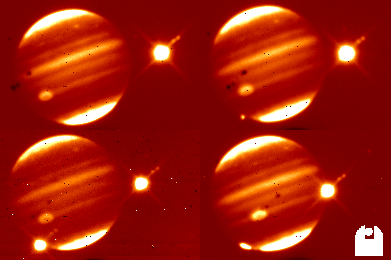
NOTE: Click on the image to view it at its highest resolution.
A time sequence of four frames showing the impact of the first of the 20 odd fragments of Comet Shoemaker-Levy 9 into Jupiter. The upper left frame shows Jupiter just before impact. The bright object to the right is the closest Galilean satellite Io, and the fainter oval structure in the southern hemisphere is the Great Red Spot. The polar caps appear bright at the wavelength of the observations, 2.3 um, which was selected to maximize contrast between the fireball and the jovian atmosphere. In the second frame, taken from Spain at about 10:15pm on July 16, the fireball appears above the southeast (lower left) limb of the planet. The fireball flared to maximum brightness within a few minutes, at which time its flux surpassed that of Io. The final frame shows Jupiter approximately 20 minutes later when the impact zone had faded somewhat. Further monitoring suggests that the bright zone is rotating slower than the cloud deck on Jupiter, implying that the fireball is high in jovian atmosphere. At the time of this writing nearly three hours after the event, remnant flux is still visible. These images were taken at the German-Spanish 3.5 meter telescope on Calar Alto in southern Spain, using the near infrared camera of the Max-Planck-Institut fuer Astronomie in Heidelberg, Germany.
Members of the Calar Alto observing team: Max Planck Institut fuer Astronomie (Heidelberg, Germany) Tom Herbst Kurt Birkle Ulrich Thiele Max Planck Institut fuer Kernphysic (Heidelberg, Germany) Doug Hamilton Universitaets-Sternwarte Muenchen (Muenchen, Germany) Hermann Boehnhardt Alex Fiedler Karl-Heinz Mantel Instituto de Astrofisica de Andalucia (CSIC Granada, Spain) Jose Luis Ortiz Astrophysical Institute Arcetri (Florence, Italy) Giovanni Calamai Andrea Rickicki
